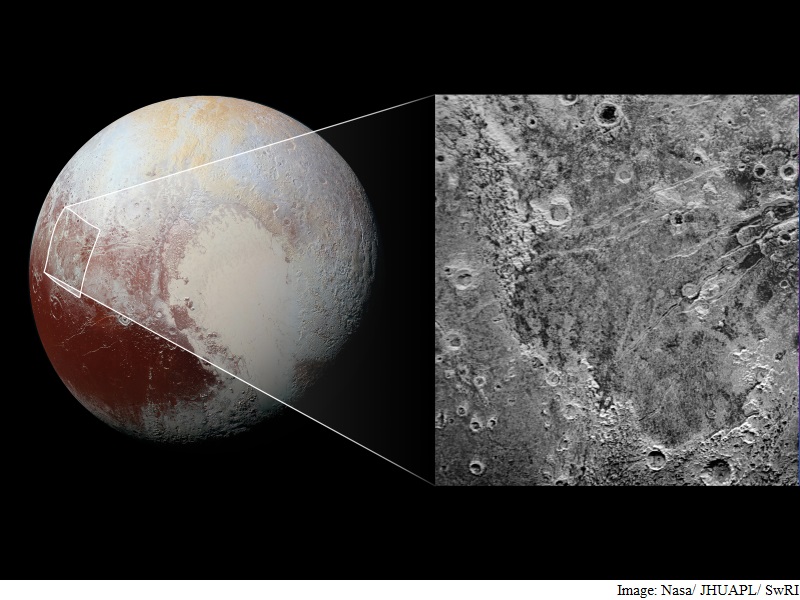- Home
- Science
- Science News
- Giant 'Bite Mark' Appears on Pluto's Surface
Giant 'Bite Mark' Appears on Pluto's Surface

The team suspect it may be caused by a process known as sublimation - the transition of a substance from a solid to a gas.
The methane ice-rich surface on Pluto may be sublimating away into the atmosphere, exposing a layer of water-ice underneath.
The data from the New Horizons spacecraft indicate that the plateau uplands south of Piri Rupes are rich in methane ice.
Scientists speculate that sublimation of methane may be causing the plateau material to erode along the face of the cliffs, causing them to retreat south and leave the plains of Piri Planitia in their wake.
The data also show that the surface of Piri Planitia is more enriched in water ice than the higher plateaus.
It may indicate that Piri Planitia's surface is made of water ice bedrock, just beneath a layer of retreating methane ice.
Because the surface of Pluto is so cold, the water ice is rock-like and immobile.
The images were obtained by New Horizons at a range of approximately 33,900 kms from Pluto, about 45 minutes before the spacecraft's closest approach to Pluto on July 14, 2015.
Earlier, in yet another example of Pluto's fascinating and abundant geological activity, New Horizon captured nitrogen ice glaciers carrying an intriguing cargo - numerous, isolated hills that may be fragments of water ice from Pluto's surrounding uplands.
These hills individually measure one to several miles or km across, a Nasa statement said.
The hills, which are in the vast ice plain informally named Sputnik Planum within Pluto's "heart" are likely miniature versions of the larger, jumbled mountains on Sputnik Planum's western border.
Because water ice is less dense than nitrogen-dominated ice, scientists believe these water ice hills are floating in a sea of frozen nitrogen and move over time like icebergs in the Earth's Arctic Ocean.
The hills are likely fragments of the rugged uplands that have broken away and are being carried by the nitrogen glaciers into Sputnik Planum.
Catch the latest from the Consumer Electronics Show on Gadgets 360, at our CES 2026 hub.
Related Stories
- Samsung Galaxy Unpacked 2025
- ChatGPT
- Redmi Note 14 Pro+
- iPhone 16
- Apple Vision Pro
- Oneplus 12
- OnePlus Nord CE 3 Lite 5G
- iPhone 13
- Xiaomi 14 Pro
- Oppo Find N3
- Tecno Spark Go (2023)
- Realme V30
- Best Phones Under 25000
- Samsung Galaxy S24 Series
- Cryptocurrency
- iQoo 12
- Samsung Galaxy S24 Ultra
- Giottus
- Samsung Galaxy Z Flip 5
- Apple 'Scary Fast'
- Housefull 5
- GoPro Hero 12 Black Review
- Invincible Season 2
- JioGlass
- HD Ready TV
- Laptop Under 50000
- Smartwatch Under 10000
- Latest Mobile Phones
- Compare Phones
- OPPO Reno 15 Pro Max
- Honor Win RT
- Honor Win
- Xiaomi 17 Ultra Leica Edition
- Xiaomi 17 Ultra
- Huawei Nova 15
- Huawei Nova 15 Pro
- Huawei Nova 15 Ultra
- Asus ProArt P16
- MacBook Pro 14-inch (M5, 2025)
- OPPO Pad Air 5
- Huawei MatePad 11.5 (2026)
- Xiaomi Watch 5
- Huawei Watch 10th Anniversary Edition
- Acerpure Nitro Z Series 100-inch QLED TV
- Samsung 43 Inch LED Ultra HD (4K) Smart TV (UA43UE81AFULXL)
- Asus ROG Ally
- Nintendo Switch Lite
- Haier 1.6 Ton 5 Star Inverter Split AC (HSU19G-MZAID5BN-INV)
- Haier 1.6 Ton 5 Star Inverter Split AC (HSU19G-MZAIM5BN-INV)

















